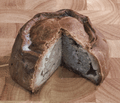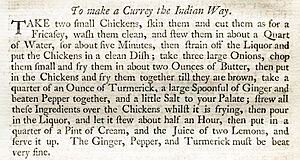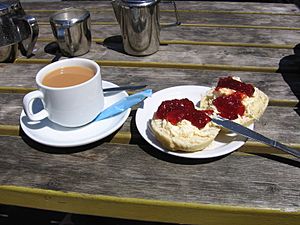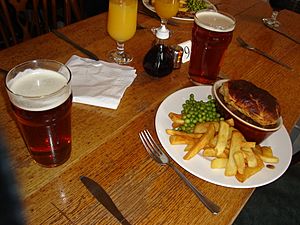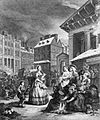English cuisine facts for kids
English cuisine includes all the cooking styles, traditions, and recipes from England. It has its own special qualities, but it also shares a lot with other British foods. This is partly because of ingredients and ideas brought from places like the Americas, China, and India during the time of the British Empire. Also, after World War II, many people moved to the UK, bringing their food traditions with them.
Some classic English meals, like bread and cheese, roasted meats, meat pies, boiled vegetables, and fish from rivers and the sea, are very old. A cookbook from the 14th century, called The Forme of Cury, has recipes for these dishes and was written for King Richard II's royal court.
English cooking has been changed by foreign ingredients and styles for a long time, even since the Middle Ages. For example, Curry came from India and was changed to suit English tastes starting in the 1700s. Hannah Glasse even had a recipe for chicken "currey" in her cookbook. Later, French cuisine became popular in England during the Victorian era. After World War II, when food was rationed, Elizabeth David's 1950 book A Book of Mediterranean Food became very popular. It helped bring Italian cuisine into English homes. Her success encouraged other writers to share recipes from places like China and Thailand. England still welcomes new food ideas from all over the world today.
Contents
History of English Food
English cooking has grown and changed over many centuries.
Food in the Middle Ages
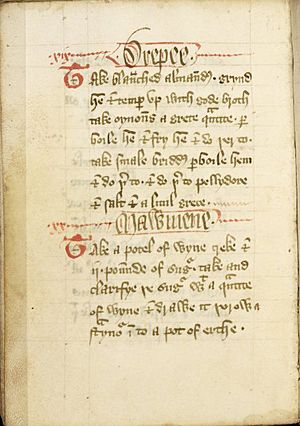
English cooking has been developing for a very long time, at least since the book The Forme of Cury was written around 1390, during the reign of King Richard II. This book has creative and fancy recipes. Many sauces were sweet and sour and made thicker with bread or ground almonds. Dishes like gingerbread are also described.
Contrary to what some movies show, it wasn't just big pieces of roast meat at every meal. Many medieval dishes were like pureés, sometimes with small bits of meat or fish. About half the recipes in one old manuscript are for stews or purees. These dishes could be:
- A bit sour, using wine, vinegar, and spices, thickened with bread.
- Sweet and sour, using sugar and vinegar.
- Sweet, using sugar, which was very expensive back then.
For example, a rich, yellow dish called "Mortruys" was a sweet puree made with meat (or fish) and thickened with egg.
The 1500s

In the early 1500s, printed cookbooks slowly started to appear. The very first one, The Boke of Cokery, came out in 1500. More books followed, like A Proper Newe Booke of Cokerye after 1545. Later in the century, many more titles were published, including The Good Huswifes Jewell by Thomas Dawson in 1585. These books were for different types of people: some had "secrets" about sweets and health remedies for rich ladies, while others gave cooking and household advice for women from more ordinary families.
English tastes changed in the 1500s in a few ways:
- Recipes started to balance sweet and sour flavors.
- Butter became an important ingredient in sauces.
- Herbs, which could be grown locally, started to be used more instead of spices for flavor.
Even with these changes, many meat recipes still used the old mix of sugar and dried fruit. New ingredients also arrived from far-off lands. The Good Huswifes Jewell even included sweet potatoes from the Americas alongside older recipes.
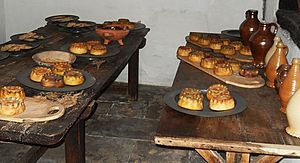
Elinor Fettiplace's Receipt Book, written in 1604, gives us a close look at Elizabethan cooking. It has recipes for different breads, apple fritters, preserves, pickles, and even a huge cake for 100 people! New ingredients like citrus fruits appeared. For example, a recipe for mutton called for wine, cinnamon, sugar, cloves, mace, and orange peel. It also used the juice of a lemon.
Pies were very important, both as food and for show. The nursery rhyme "Sing a Song of Sixpence" talks about "Four and Twenty blackbirds / Baked in a pie." This refers to a trick where live birds were put under a pie crust just before serving at a feast!
The 1600s
The most popular cookbook in the early 1600s was Gervase Markham's The English Huswife, published in 1615. It seems his recipes came from a collection belonging to a noblewoman who had passed away, so they were from earlier times. Women were starting to write and read cookbooks, even though only about 10% of women in England could read by 1640. Markham's recipes were different from medieval ones. Most of his sauces for meat and pies mixed sweet and sour flavors. He advised cooks to balance tastes: if a broth was too sweet, add verjuice (sour grape juice); if too tart, add sugar; if bland, add orange and lemons; and if too bitter, add herbs and spices.
Robert May's The Accomplisht Cook came out in 1660. It had many recipes for soups and stews, and a lot of pies with fish, meat, and sweet fillings.
French cooking started to influence English recipes, as seen in Hannah Woolley's The Cooks Guide from 1664. Her recipes helped ordinary people try to cook in the fancy French style with detailed sauces. She mixed French ingredients like Claret wine and anchovies with more traditional English ones like sugar, dried fruit, and vinegar.
The 1700s
John Nott's The Cooks and Confectioners Dictionary (1723) was one of the first cookbooks to list recipes alphabetically, from "Al" (for Ale) to "Zest." It covered everything from soups and salads to meat, fish, pastries, sweets, and even how to make beer, cider, and wine. It also suggested menus for each month of the year.
James Woodforde's Diary of a Country Parson gives a good idea of what wealthy people ate in England in the 1700s. For example, on June 8, 1781, he served his neighbors:
- First course: Boiled Chicken, tongue, boiled leg of Mutton with capers, and Batter Pudding.
- Second course: Roasted ducks with green peas, Artichokes, tarts, and Blancmange.
- After dinner: Almonds, raisins, oranges, strawberries, and Port Wine.
Another clergyman, Gilbert White, wrote in The Natural History of Selborne (1789) about how ordinary country people in southern England were eating more vegetables. He noted that potatoes, which came from the Americas, had only been added to their diet during the time of King George III.
Hannah Glasse's The Art of Cookery Made Plain and Easy was the most popular cookbook for a century after it was published in 1747. It was printed at least 40 times and was copied by many others.
The 1800s

English cooking became more organized and available to middle-class families through popular cookbooks. Mrs Rundell's A New System of Domestic Cookery (1806) was one of the first, selling hundreds of thousands of copies. Then came Eliza Acton's Modern Cookery for Private Families (1845), which some call "the greatest cookery book in our language."
Acton was later replaced by the most famous English cookbook of the Victorian era: Isabella Beeton's Mrs Beeton's Book of Household Management (1861). It sold nearly two million copies by 1868. While Acton's book was meant to be read and enjoyed, Beeton's was more of a guide with instructions and recipes to look up when needed.
Three major hot drinks popular in England—tea, coffee, and chocolate—all came from outside Europe and were common by Victorian times.
- Catherine of Braganza brought the Portuguese habit of drinking tea to England around 1660. At first, it was very expensive, but the price dropped over time, and by the 1800s, everyone drank it.
- Coffee became popular by the 1600s, especially in coffee houses. The first one opened in Oxford in 1650.
- Hot chocolate was a popular drink by the 1600s, long before chocolate was eaten as a solid food. Chocolate bars were later created and sold by English Quaker businesses like Joseph Fry's (1847), Rowntree's (1862), and Cadbury's (1868).
The 1900s
After the First World War, many new food products became available. Packaged foods were advertised as convenient. Instead of making custards and puddings from scratch, housewives could use instant mixes or jarred foods. American-style dry cereals started to compete with traditional breakfasts like porridge or bacon and eggs. While wartime shipping problems limited choices, the 1920s brought many new fruits from around the world, along with better packaging and hygiene, helped by refrigerators and refrigerated ships.
Rationing began in 1940 to deal with food shortages caused by the war. Foods like bananas, onions, and chocolate became hard to find. Unfamiliar items like dried egg, dried potato, and Spam appeared. Since butter, sugar, eggs, and flour were all rationed, classic English dishes like pies and cakes were hard to make. Instead, carrots were used in many dishes, even in new sweets like carrot fudge, because of their natural sugars. The diet wasn't very enjoyable, but strangely, rationing meant people were healthier than ever before. The Ministry of Food taught people how to cook cheaply. After the war, Marguerite Patten became one of the first TV cooks and sold millions of cookbooks.
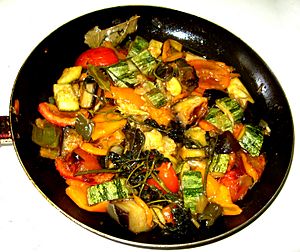
Elizabeth David greatly changed English cooking with her 1950 book A Book of Mediterranean Food. She wrote it during a time of food shortages. Her book described the cooking of Mediterranean countries, focusing on honest home cooking rather than fancy restaurant food. Her books encouraged other cookbook authors to use foreign recipes.
Common English Dishes
Many people in Britain might agree that typical national foods include the full English breakfast, roast beef, tea with scones, and fish and chips. However, few people eat all of these in one day, and many don't eat them regularly. The national diet changes over time, and cookbooks often include dishes from other countries. For example, a cafe might serve curry, even if it says it doesn't serve "foreign food," because curry is now seen as English! Anglo-Indian cuisine has been part of the national diet since the 1700s.
Many dishes thought of as traditional English are actually quite new. For example, piccalilli came from India in the 1700s. On the other hand, some dishes and sauces still seen as foreign, like fish in sweet and sour sauce, have been in English recipe books since the Middle Ages. Other dishes, like the "Full English breakfast," developed slowly over time.
-
Fish and chips, from around 1870.
-
A Melton Mowbray pork pie, by the 1780s.
-
Piccalilli, a pickle from Indian cooking, by 1758.
-
English sandwiches, by 1762.
-
Full English breakfast (1800s) with sausage, bacon, tomatoes (from the Americas, by 1700s) and eggs.
-
Cream tea: tea (around 1660), scones (Scottish, 1500s), clotted cream, raspberry jam (1000s).
-
Sunday roast: roast beef (by 1700s), roast potatoes, vegetables and Yorkshire pudding (1747).
-
Steak and kidney pudding (1861).
-
Pasty (1200s).
-
Dessert: Spotted dick (1800s) with custard (Roman and medieval).
-
Ice cream cone (1846).
Foreign Influences on English Food
English cooking has been open to foreign ingredients and ideas since at least the 1200s. Even a few foods like sausages have Roman origins. Rich people in England would buy large amounts of spices like cinnamon, pepper, and ginger, as well as expensive imported sugar. Spices were not used to hide bad meat, but perhaps to hide the taste of salt, which was used to preserve food before refrigerators existed.
Some people claim that "The English have never had a cuisine." However, many cookbooks, like Mrs Beeton's Book of Household Management, include many recipes from India. Even popular dishes like fish and chips have foreign roots: the fried fish came from Jewish cooking, and the potato chips came from France. French cooking strongly influenced English food throughout the 1800s, and French chefs still do today.
The Role of the British Empire
Curry was created when the British arrived in India in the 1600s. It started as spicy sauces used to add flavor to boiled and roasted meats. The 1758 edition of Hannah Glasse's The Art of Cookery has a famous recipe called "To make a currey the Indian way." It uses chicken with onions, turmeric, ginger, pepper, and is stewed with cream and lemon juice.
The way Indian cooking was adapted continued for centuries. Some Anglo-Indian recipes ignored Indian food rules, for example, by using pork or beef. Some dishes, like "liver curry, with bacon," were just regular recipes spiced up with curry powder. Other Indian dishes, like kedgeree, were changed to suit British tastes. Curry was included in almost all Victorian era cookbooks. By 1895, curry was even in books for poorer families.
Foreign influence wasn't just about specific dishes. Historians argue that potatoes, sugar (which was all imported until around 1900), tea, and coffee, along with more spices, were "Fruits of Empire" that became common in Britain between 1660 and 1800. By the 1800s, their foreign origins were forgotten, and they became a normal part of daily life.
Indian and Anglo-Indian Food

During the British Raj (British rule in India), Britain started borrowing Indian dishes, creating Anglo-Indian cuisine. Examples include Kedgeree (1790) and Mulligatawny soup (1791). Indian food was served in coffee houses from 1809, and cookbooks from that time show it was cooked at home too. The Veeraswamy restaurant in London, opened in 1926, first served Anglo-Indian food and is the oldest Indian restaurant still open in Britain. The number of curry houses grew a lot in the 1940s and again in the 1970s.
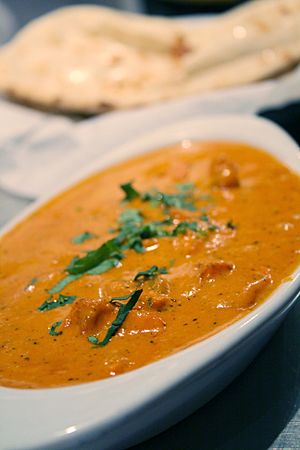
The modern Anglo-Indian dish chicken tikka masala was supposedly invented in Glasgow in the early 1970s. Balti cuisine came to Britain in 1977 in Birmingham. In 2003, there were about 9,000 restaurants serving Indian food in Britain. Most of these Indian restaurants are run by people from Bangladesh and Pakistan. The Indian food industry in the UK was worth £3.2 billion in 2003, making up two-thirds of all meals eaten out.
Indian restaurants in Britain slowly improved from having similar menus. The Bombay Brasserie, which opened in London in 1982, served food actually eaten in India. By 2001, two Indian restaurants in London, Tamarind and Zaika, earned Michelin stars for their excellent cooking.
Indian cuisine is the most popular alternative to traditional cooking in Britain, followed by Chinese and Italian food. By 2015, chicken tikka masala was one of Britain's most popular dishes.
Other Influences
Asian foods have become widely available across England. Chinese cuisine became common in England by the 1970s, with large cities often having a Chinatown. The first one, in London's Soho, grew between the two world wars. The food served by Chinese restaurants is often based on Cantonese cuisine but has been changed to suit English tastes. From around 1980, Southeast Asian foods, especially Thai and Vietnamese, started to become popular in England.
Italian cuisine is the most popular Mediterranean cuisine in England. Its rise, with lots of pizza and pasta, began after 1945, inspired by Elizabeth David. Before World War II, there were some Italian restaurants, but they mostly served general fancy food. Soon after the war, Italian coffee bars appeared, selling simple and cheap Italian food like minestrone soup, spaghetti bolognese, and pizza. From the early 1960s, slightly fancier trattoria restaurants offered "Italian specialities" like lasagne. Other Mediterranean influences include Greek moussaka, feta, and taramasalata; Turkish doner and shish kebabs; and Middle Eastern hummus.
French cuisine is mostly found in expensive restaurants, though there are some cheaper French bistros. For many years, English writers were unsure about French cooking. However, restaurants serving French haute cuisine (fancy cooking) grew for the upper and middle classes in England from the 1830s. Escoffier was hired by the Savoy Hotel in 1890. Marcel Boulestin's 1923 book Simple French Cooking for English Homes helped make French dishes popular.
Places to Eat in England
Cafes and Tea Shops
An English cafe is a small, cheap place to eat. A traditional cafe for working people serves mostly fried or grilled food, like fried eggs, bacon, bangers and mash, black pudding, bubble and squeak, burgers, sausages, mushrooms, and chips. These might come with baked beans, cooked tomatoes, and fried bread. These are often called "breakfast" even if they are available all day. Traditional cafes have become less common with the rise of fast-food chains, but many still exist.
A tea shop is a small restaurant that serves soft drinks and light meals, often in a calm setting. Customers might have a cream tea (Cornish or Devonshire style), served with scones, jam, and clotted cream.
Fish and Chip Shops
Fish and chips is a hot dish of battered fish, usually Atlantic cod or haddock, and chips. It's a very common take-away food.
Jewish people who settled in England from the 1500s would have made fried fish. Chips appeared in the Victorian era; Charles Dickens's 1859 book A Tale of Two Cities mentions "husky chips of potatoes, fried with some reluctant drops of oil." Fish and chip shops in the 1920s were often run by Jewish or Italian families. Even so, the new dish was often said to be from France.
Pub Food
The public house, or pub, is a famous English place. In the mid-1900s, pubs were mainly for drinking, with little food other than "bar snacks" like pork scratchings, pickled eggs, salted crisps, and peanuts, which helped sell more beer. If a pub served meals, they were usually simple cold dishes like a ploughman's lunch, which was invented in the 1950s.
In the 1950s, some British pubs started offering "a pie and a pint," with hot individual steak and ale pies made easily by the landlord or his wife. In the 1960s, this grew into "chicken in a basket." The quality of pub food sometimes dropped with the use of microwave ovens and freezer food. But "pub grub" expanded to include British foods like steak and kidney pudding, shepherd's pie, fish and chips, bangers and mash, Sunday roast, and pasties. The gastropub movement of the 2000s aims to serve restaurant-quality food, cooked fresh, in a pub setting. Some gastropubs have even earned Michelin stars.
Vegetarianism in England
Modern Western vegetarianism started in the United Kingdom in 1847 with the world's first Vegetarian Society. It has grown a lot since the end of World War II. By 2003, there were between 3 and 4 million vegetarians in the UK, one of the highest numbers in the Western world. About 7 million people say they don't eat red meat. By 2015, 11 out of 22 restaurant chains had at least one vegan main course on their menu.
Quality of English Food

English cuisine in the 1900s had a poor reputation around the world. People often thought English food was bland, but English cooking has used many spices since the Middle Ages. It also brought curry to Europe and uses strong flavors like English mustard. It was also thought to be boring, like roast beef. However, roast beef was highly valued in Britain and other countries, and few people could afford it. The "Roast Beef of Old England" in William Hogarth's 1748 painting celebrated the high quality of English cattle.
The years of wartime shortages and rationing certainly made English food less varied and flavorful in the 1900s. But the nation's cooking recovered with more money and new ingredients becoming available soon after the Second World War.
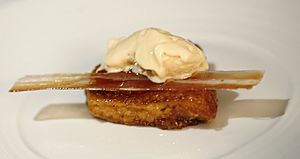
In 2005, 600 food critics named 14 British restaurants among the 50 best in the world. The number one was The Fat Duck in Bray, Berkshire, led by chef Heston Blumenthal. The quality of London's best restaurants has made the city a top place for international food.
Also, the number of UK food and drink products with special protected status under European Union law has grown quickly. In 2015, 59 items were listed, including Cornish sardines, Yorkshire Wensleydale cheese, and traditional Cumberland sausage. By 2016, there were 12 cheeses from England with this special status.
Images for kids
-
Tom King's Coffee House in William Hogarth's painting Four Times of the Day, 1738.
See also
 In Spanish: Gastronomía de Inglaterra para niños
In Spanish: Gastronomía de Inglaterra para niños






